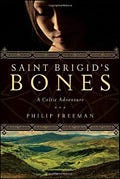Set in sixth-century Ireland, Saint Brigid's Bones is a mystery (not a murder mystery, but otherwise true to the genre), which features a young nun in the monastic community of Kildare, founded by Saint Brigid around 480. It portrays life in an Irish monastery at a time when paganism was still practiced openly, and the tolerant Irish strain of Christianity contrasted sharply with the more rigid style of mainland Europe. Briskly paced and easy to read, the story revolves around the conflicts between these three different approaches to religion and their relationship to power politics in early Christian Ireland.
Deirdre submits to her abbess's rule, but in the still-pagan world of the Irish aristocracy she continues to have the authority of her past status as a bard. When someone steals the bones of Saint Brigid, said to have healing powers, from the monastery church, the loss of income from pilgrims pushes the community to the brink of disaster. Deirdre's bardic background makes her the obvious choice to find and retrieve the bones. As she searches, she encounters a charismatic past lover; her ex-husband; an elderly king and his greedy, ill-mannered sons; a power-hungry bishop; and a variety of other characters drawn in broad, colorful strokes.
If some of the characters are mystics, the novel comes down firmly on the side of rational explanation - so firmly that Deirdre sometimes feels like a modern rationalist in ancient Celtic dress. And if it accurately portrays the setting's factual background, the psychology and behavior of the characters sometimes challenge credibility. In a world of guile, for example, guileless young Dierdre repeatedly approaches dangerously violent characters, including a group of brutal outlaws, to question them directly about the theft. For readers comfortable suspending disbelief, though, Saint Brigid's Bones is an enjoyable, educational tour through a fascinating lost world. (2014; 227 pages, including a brief Afterword about the history behind the novel)





Glad you enjoyed the review--and especially the book! It's not often that a mystery which doesn't involve a murder (even if it did involve human bones) really works as a mystery. The real fun, for me, was being immersed in Celtic culture right on the edge between paganism and Christianity.
Excellent review of a book I also enjoyed! I believe I was also already a fan of Sister Fidelma in the Peter Tremayne series when I discovered this book and was excited to find another in that general time/place.